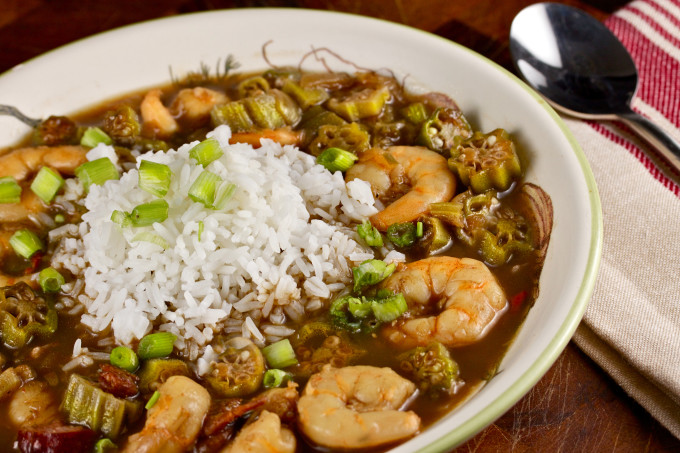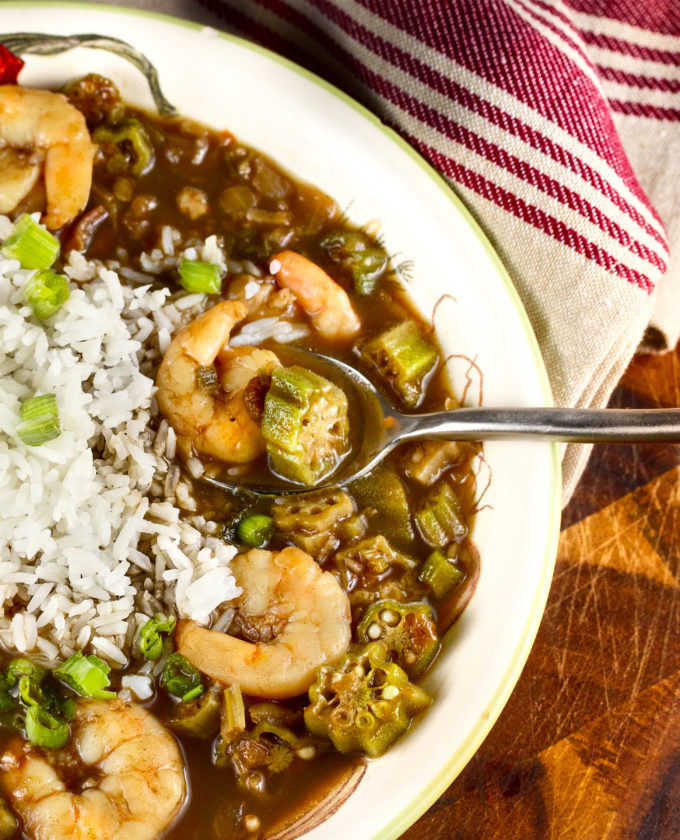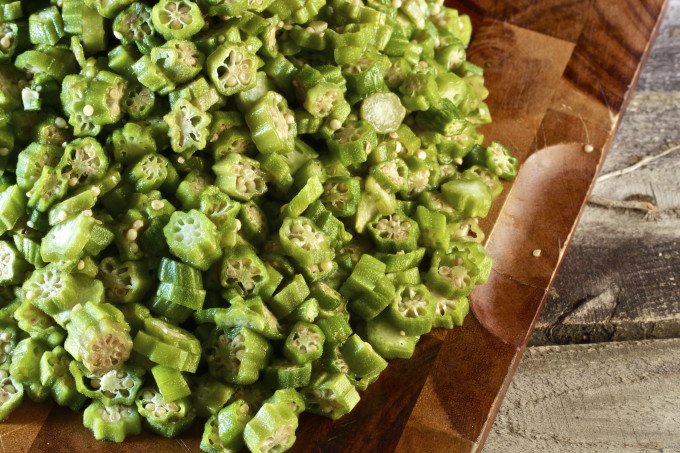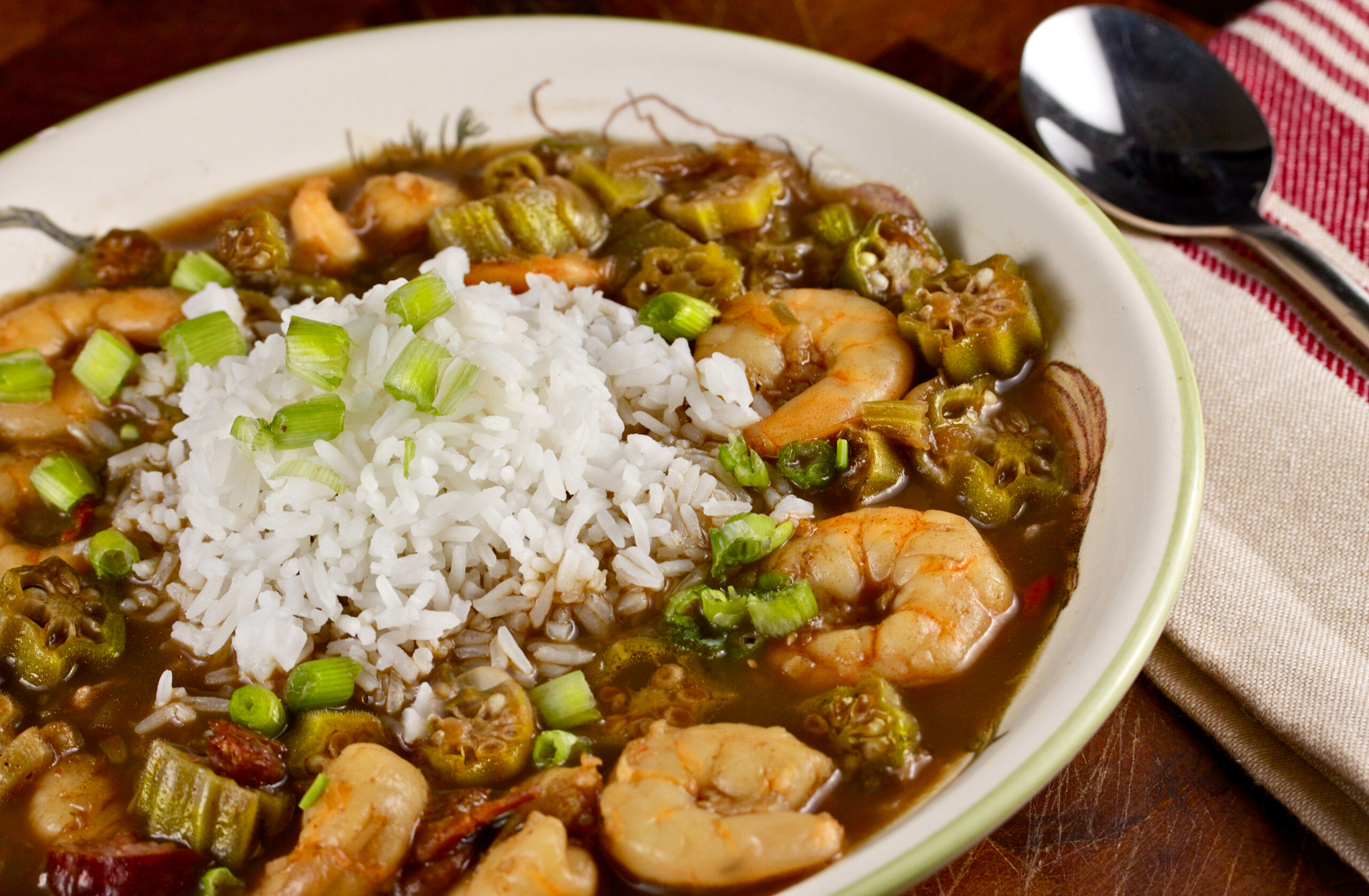Just last week I was telling a good friend that I had plans to make shrimp and okra this weekend. Without hesitation, she asked, “Cajun gumbo or Creole gumbo?” Oh, here I am again. After a 10-minute explanation, I saw my friend regret even asking the question. But it is a difficult subject, and one in which the highest level of scientific study has been involved. If you have a little ten minutes to be ashamed of, pour another cup of coffee and hear me out.

Shrimp and okra gumbo blends the best of Cajun and Creole cooking into one delicious bowl. (All photos: George Graham)
So what is the difference between Cajun cooking and Creole cooking? For a food writer from Louisiana covering Cajun and Creole cooking, this is like asking, “What’s in okra?” There is no clear answer, and that is the beauty of culture and cuisine. At the risk of getting bogged down in culinary controversy, let me shed some light on this long and sometimes heated debate.
The difference between the two can be easily explained by looking at the two cultures and their geography. Europeans of wealth and status settled in New Orleans and brought with them a more refined taste of cuisine reminiscent of their French, Spanish or English roots. Over time, African-descendant butlers and cooks learned these sophisticated recipes and techniques and blended them into their own spicy, herb-infused cooking. Before long, the tastes melded into a soulful blend that became the signature taste of Creoles. Cooking with tomatoes, cream, butter, cheese, and other refined ingredients resulted in the rich cuisine that New Orleans was famous for. French sauce techniques have helped define dishes such as shrimp remoulade, trout meunier, oysters bienville, crab meat ravigote and many other great Creole dishes. Those classic European dishes are joined by home-brewed Creole foods like okra zherbes, smoked red beans and rice, and dishes stewed with okra, as well as a tomato-infused version of jambalaya.
Meanwhile, in the swamps of southwest Louisiana a different kind of culinary evolution was taking place. In 1755, the expulsion of the French Acadians from Nova Scotia by the British led thousands of families to migrate to the wetlands of southern Louisiana. Along the Gulf Coast and north in the prairie region of Acadiana, settlers put down roots. These were not wealthy people, but rather simple farming families. To survive, they trapped, hunted, and fished, applying their basic skills in rustic French cooking to simple Cajun recipes to suit their taste. Settlers along the coastal parishes made a living by harvesting shrimp, crab, and shellfish. Inland, flatland farming with sugarcane and rice as the dominant crops led to Cajun recipes using all of these indigenous ingredients. The Atchafalaya Basin was a wild source of crayfish, and eventually the rice paddies were flooded after harvest to grow the crayfish in a controlled aquaculture environment. Over time, Germans settled the area north of Lafayette and brought with them sausage-making and smoking skills that blend beautifully into the flavorful gumbo we now know as Cajun cooking.

Shrimp and okra is a recipe that connects Louisiana cultures.
Family plays an important role in the ways of Cajun food. Even today, celebrations break out whenever families gather to cook a whole hog. Boucheri and cochon de lait are important French traditions of the Cajun way of life. Even crayfish boils are family celebrations that bring people together over food. Food is an essential component of the joy of life in South Louisiana.
I’ve heard Cajun food described as a basic, unrefined take on rustic country cooking. I disagree. For me, this description changes the talent and taste of French Acadian gastronomy. I believe that the evolution of this distinctly indigenous cuisine is based on artisanal techniques handed down through generations and preserved as a cultural treasure. Pride and passion for Cajun cooking is as defining to the people as music, dance, and language. Bold and dark gumbo, spicy tasso, rich lobster, black rice and gravy are authentic Cajun recipes steeped in the historical reverence of the culture that still lingers.
But the explanation does not end there.
I would argue that over time, Cajun and Creole cuisines have transformed into a uniquely multicultural cuisine that is represented throughout Louisiana. The holy trinity of spices—onion, bell pepper, and celery—is the divine starting point for both cuisines. Okra often appears in the bamboos on either side of the Atchafalaya basin, and a bowl of creamy red beans with smoked andouille is the deliciously connecting link between the two cultures. The beauty of eating Louisiana is the blending of flavors into unique dishes that are unexpected and one-of-a-kind.
Let the discussion end. What is true Louisiana cuisine? who cares? The blurring of the lines of distinction between these two cultures has given rise to a truly unique, indigenous cuisine. To celebrate and illustrate this union, I offer a hot bowl of shrimp and okra.
One bite and you will clearly understand.

Freshly chopped okra adds a Creole twist to this Cajun shrimp and okra recipe.
Jumbo shrimp and okra
Recipe by: George Graham – AcadianaTable.com
Serve: 6 to 8
ingredients
- Half a cup of canola oil
- 2 cups yellow onion, cut into cubes
- 2 cups green pepper, cut into cubes
- 2 cups celery, cut into cubes
- 2 tablespoons of minced garlic
- A quarter cup of chopped parsley
- 1 cup minced Tasso or smoked ham
- 2 tablespoons of tomato paste
- 12 cups shrimp broth or seafood broth, plus water if needed
- 1 cup dried shrimp
- 2 cups okra, cut into slices
- 1 1/2 cups dark roux, such as Rox’s Roux
- 1 tablespoon of cayenne pepper
- Kosher salt and freshly ground black pepper
- 3 pounds fresh large Louisiana shrimp
- Dash of hot sauce
- 8 cups cooked Louisiana white rice, to serve as a supreme
- 1 cup green onion cubes
- File powder
directions
- In a large cast iron saucepan over medium heat, add 1/2 cup canola oil. Once hot, add the onions, bell peppers, and celery. Fry until the onion becomes translucent. Add garlic, parsley, and tasso, and toss to combine. Add tomato paste and stir.
- Add shrimp broth with dried shrimp. Add the chopped okra. Bring to a boil and add the roux. Reduce the heat to a simmer and season with hot pepper. Cover the pot and let it cook for an hour.
- After one hour, lift the lid and scrape the surface of any excess oil. Taste the okra. If you prefer a thinner okra, add more broth or water. Add salt and pepper to taste. Add the shrimp, cover the pot, and simmer for another 20 minutes. Turn off the fire.
- Uncover the pan and scrape the surface of any excess oil. Taste ready-made okra and season with hot sauce to taste.
- Place the okra in large bowls on top of a pile of rice and garnish with the diced green onions. Lay out the fillet powder and hot sauce on the counter to add. Served with hot french bread.
notes
3.5.3217

Blending a dark Cajun roux with Creole okra is the basis for incorporating fresh Gulf shrimp into this shrimp and okra gumbo—a classic Southern Louisiana dish.
Your seat at the table: If you love this Cajun cooking story then this Cajun recipe is for you aAccept my personal invitation to sign up by entering your email at the bottom or top right of this page. It is fast and painless. You’ll receive an email alert and be the first to see when new Cajun cooking stories and Cajun recipes are added.
Thanks, George.

